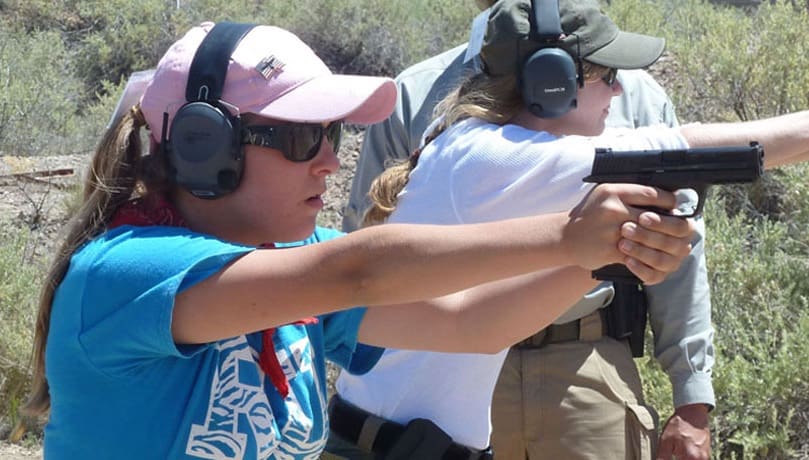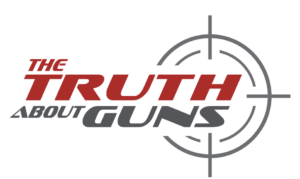Did you ever build a pinhole camera in grade school? That’s pretty much how I got my start in photography. Even a kid can make one because there’s no lens. Just a, er, pin-size hole in the front of a box that focuses a beam of light on a piece of photo paper in the back. And because the pinhole is so small, you get huge depth of field. Translation: virtually everything in front of the camera in focus. And that’s the principle behind the EyePal Peep Sight system. If you’re of a certain age and shoot with iron sights, chances are you have trouble keeping both your target and your sights in focus. And that’s the problem the EyePal is designed to remedy. For only $29.95. Press release after the jump . . .
ACTON, MA (December 2013) – The EyePal® Peep Sighting System, developed for the open-sight shooter, was designed and patented by Charles Summers, a retired MIT optical specialist and avid firearms enthusiast. Frustrated with his inability to properly see his sights and target without suffering from “fuzzy sight syndrome”, Summers came up with a solution that brings into focus the sights and the target simultaneously. Whether a shooter or archer suffers from vision difficulties or aging eyes or is new to the sport, the EyePal’s unique aperture system provides an immediate sense of eye relief as the image of the target and all of the elements come clearly into focus.
The EyePal® is applied easily onto any protective eyewear. The small aperture provides the maximum depth of field. It does this by producing a very small image which travels, undistorted, through both the lens of the eyewear and the pupil of the eye. The result is a perfectly focused sight picture of both sights and the target. One of the reasons this is possible is that the EyePal’s large black area surrounding the target or game blocks the unnecessary peripheral visual information allowing the eye to get only the necessary information to make a clear shot.
The EyePal® is available in three versions: Rifle or Handgun Kits include two identically sized apertures matching their kit application and the Master Kit includes one rifle and one handgun aperture. The EyePal® apertures come in a handy storage case. Simply open the top of a well and place your EyePal® on the glasses. The EyePal® can be easily removed and relocated until the perfect sight line is achieved. The EyePal® is approved at the NRA CMP National Matches and is available online or ask your favorite retailer. MSRP $29.95.
EyePal® Peep Sighting System
Resident Artist Studio, LLC
241 Arlington Street #773
Acton, MA 01720
P: 978-635-9162









Out here in small town Texas, I wave at everybody, my neighbor asked me why did I do that if I don’t know them? I told him there might come a time I need to know them.
How’s that gun control, hope and change and legal pot working out for you CO?
Let me ask you something. If the rule you followed brought you to this, of what use was the rule?
Different guy, same BS. Oh, and “comments closed.” So brave, so brave.
Between the overwhelming desire to not have a firearm anywhere close to pointing at my genitals or my upper leg (which houses some pretty sensitive blood vessels and important bones that I’ve grown to like), and the fact that I’m the proud owner of a beer gut, appendix carry just isn’t happening for this guy.
Prayers for the families affected. On a side note what if a fires destroyed schools as often as there are school shootings? Would the American people suggest that a simple sign on all entryways banning fires from school property be a sufficient safeguard?
Hi Chris,
Long time.
“41 new laws in 21 states and DC made it harder for people to … carry them in public …”
Is there a State that has gone from shall to may issue this year? Is there a State that has designated more locations off-limits for carrying this year? Is there a State in which it became harder this year to carry a gun in public in some other sense?
I’d rather be thought a gun bully than a gungrabbing bullshitter.
Are you serious? Gun laws have helped a lot. Yes, most gun deaths are not the fault of people buying legal firearms from stores. They are mostly people taking said guns from family members. But let’s not have gun laws that require gun locks because that’s unamerican. You will make every excuse to criticize. I’m a third generation Californian. My previous two generations were L.A. cops. Neither were NRA members, both loved gun laws because they do help. They stop crazy people and criminals from getting assault rifles. They should go further. Nobody needs an assault rifle. California is better than texas or Oklahoma in their concealed carry laws. Nobody needs to carry a gun but cops. And if you can’t get ammo, neither can criminals. Look at gun crimes in countries that don’t allow gun ownership. Its a hell of a lot lower than the US. I’m an American but I think that the second amendment was for another time and outdated just like slaves and monarchies. Get over it. Stop complaining and spent your money on education instead of destructive devices. Nobody needs to defend themselves that much. The government isn’t organized enough to stop all of your rights so just shut up. Please. It would make many lives better.
Back in February, I bought a handgun from a private dealer off armslist and he insisted that he’d only sell the gun to a person with a valid CCW permit because he didn’t want to sell his handgun to a prohibited possesor. That’s the only way he could “do a background check” (kinda) on the buyer.
We could argue in circles all day about whether NICS should exist or putting private sales going through background checks, but the Libertarian in me says (with the current system we have in place) that if you are a private citizen and want to sell to anyone without the involvement of the state, that’s your right. If you, as a private citizen, wants to have access to NICS (which your taxes pay for), you should have that access. But it shouldn’t be required that we use it. Call it “pro-choice”.
ZIP was one of the formats that offered file compression and file spanning.
At this point, utilizing your UNIVERSAL SERIES BUS cable television, connect your SONY PSP
for your COMPUTER wherever you saved your test.
If not for this ability, I’d have to extract the entire archive, add the
new item to the just-extracted items, then compress the entire thing again.